It has perhaps been a little bit of an up and down experience for Matt Olson throughout the beginning of his career. We all remember when he burst onto the scene in 2017 and shocked the baseball world with an amazing 24 home runs in just 59 games and 216 plate appearances in his first run of extended playing time. He certainly made a name for himself, but in the process, the expectations became super-high. He did follow it up with a solid but probably underwhelming 28 home run, 113 wRC+ campaign in 2018. The next season though, Olson reminded us of what we could really look like at the peak of his powers, as he turned in what was (up until that point) his best performance, as he totaled 36 home runs in just 127 games. However, in the shortened 2020 season, Olson slumped mightily. His slash line was just .195/.310/.424—far from the type of player we knew Olson to be. In his own words, he stunk.
During that rough 2020, it just seemed like Olson never got fully going at the plate. On the batted-ball side of things, it mostly still looked good, though. He was making a ton of hard contact, albeit not at as strong a rate as in 2019, but he was still among the game’s best. He did, however, set a new career-high in pop-up rate at 12.8%, which suggests that he was maybe mis-hitting a few too many balls. To go along with that, he set a new career-high in strikeouts at 31.4%, which was one of the highest marks in the game last season, and up over five percent from 2019.
Additionally, he had one of the highest whiff rates in the game at 34.8%, which explains most of the surge in strikeouts. Olson, to his credit, still had excellent plate discipline, as he also set a new career-high in walk rate at 13.9%. With such a high strikeout rate, though, the extra walks just weren’t enough to offset it, and the overall ceiling of Olson’s profile became a lot lower.
Overall, with such high strikeout and pop-up rates, Olson simply made a lot of unproductive outs last season, which obviously shows up in his slash line and overall results. One thing I like to do to get a better understanding of just how many “automatic” outs a hitter makes is to combine their strikeout and pop-up rates. It’s no surprise then, among qualified hitters from last year, that Olson had one of the five-highest “auto-out” rates:
For context, the league average is somewhere around 28%, so Olson was well above the rest of the league in this department. It is quite difficult to have success with such a high rate of automatic outs, and it’s not exactly shocking to see that the hitters at the top of the leaderboard were mostly unproductive last year. Olson definitely made things harder for himself last season with all of these extra strikeouts and pop-ups, and more walks and a still strong hard-hit profile weren’t enough to fully save him.
Enough about last season, though. Let’s fast forward to 2021, where Olson is playing some of the best baseball we’ve ever seen from him. His .287/.375./578 slash line, which is good enough for a 160 wRC+, makes him look like (even though he most likely won’t win it) a legitimate MVP candidate. Even if the award probably won’t be his, it is still good to see this type of bounceback from Olson, considering how rough 2020 was for him.
As we’ve come to expect from him, Olson is still hitting the ball hard, and once again, he’s in pretty elite company among the rest of the league:
Again, Olson doing well in this department isn’t new, but things are still better than they were last season—which is impressive because he was still excellent in these areas last season. The average exit velocity mark is pretty much where it’s always been, but it is a career-high near three miles-per-hour improvement in maximum exit velocity. Additionally, his hard-hit rate is up almost three percent from last year, and his 14.6% barrel rate is nearly identical to his strong 2019 season.
While it is good and encouraging to see Olson continue to remain a force on the batted-ball side, maintaining this profile isn’t enough on its own to explain the sudden surge to this new level. Indeed, there are still some big differences in his profile.
On the batted-ball side, the major thing that’s different has been that Olson has become less of a pull hitter. Looking at the split going back to 2018, this season shows Olson with the lowest pull rate and also with the highest opposite-field rate:
At one point, Olson was pretty pull-happy, but this season, it looks like Olson has been a lot more even. Sometimes a hitter is pull-happy by choice—as oftentimes a hitter’s power output is dependant on their pull rate—but for Olson, despite most of his home runs still going to the pull-side (15 to the pull-side out of 24 total home runs), he still is hitting the ball well to all fields and getting good results along with it:
From this, we see that while the pull-side is still Olson’s best side by far, he’s getting the best results of his career to the middle of the field, and outside of 2019 (remember, he didn’t go the other way much at all in 2019), the best results when going to the opposite-field, and a marked improvement from last season. Spraying the ball all over the field more is often a good way for a hitter’s batting average to go up, especially when they’re continually hit hard, which has been the case for Olson this year, with his batting average at a career-high .287.
However, the biggest difference for Olson this season is how much he’s been able to lower his strikeout rate. Considering the highs from which he started, it is pretty incredible that he has been able to do this, and at this point in the season, it certainly does look legitimate. No other hitter has improved their strikeout rate this season as much as Olson, and the margin isn’t even close:
This is definitely significant, and not only is Olson the largest improver year-over-year, but his current 16.0% strikeout rate is by far the lowest of his career. This jump isn’t just impressive when looking back to last season, but it’s also much improved from 2019. For some additional context, Olson’s strikeout rate currently ranks in the 81st percentile, up from the ninth percentile last season, and up from the 27th percentile in 2019. In terms of whiff rate, it’s up from the eighth percentile last season and up from the 23rd percentile in 2019.
What Olson is doing this season is pretty unique. There aren’t many hitters that can hit the ball hard and for so much power while keeping the strikeouts down. Looking at things using Statcast’s percentile rankings leaderboard, we can see just that. Using some, admittedly, arbitrary cut-offs, I went looking for the hitters that ranked at to above the 70th percentile in terms of strikeout rate, as well as at or above the 80th percentile in both hard-hit and barrel rate. As it turned out, there are just three other hitters in addition to Olson who meet these criteria:
We see here the company that Olson is keeping this season, and it’s quite good company. It shouldn’t be much of a surprise that hitters who tend to limit strikeouts and hit the ball hard do very well, but it is quite rare to have it happen at such a high level as these four hitters have been able to do. It’s also not a surprise that these hitters, with their excellent contact ability and hard-hit skills, also grade out favorably well by their expected stats, with an average xwOBA that would place them collectively in the 96th percentile. At the end of the day, while it is great to hit the ball hard and all that, it’s even better to do so with more balls going in play, which Olson is definitely doing this season.
It then comes down to just how exactly Olson has been able to improve at such an impressive rate. While he is being slightly more aggressive this season compared to 2020, with career-highs in both overall swing rate and zone-swing rate at 46.4% and 71.9%, respectively, it’s not exactly a huge jump, or even all that far off from where he was at points earlier in his career. Looking at things deeper, we can see that while Olson is making more contact pretty much all over the zone, he’s making a lot more contact at the top of the zone—the part of the zone in which he previously struggled to make contact in the most. To show that, see first his contact rates from 2020:
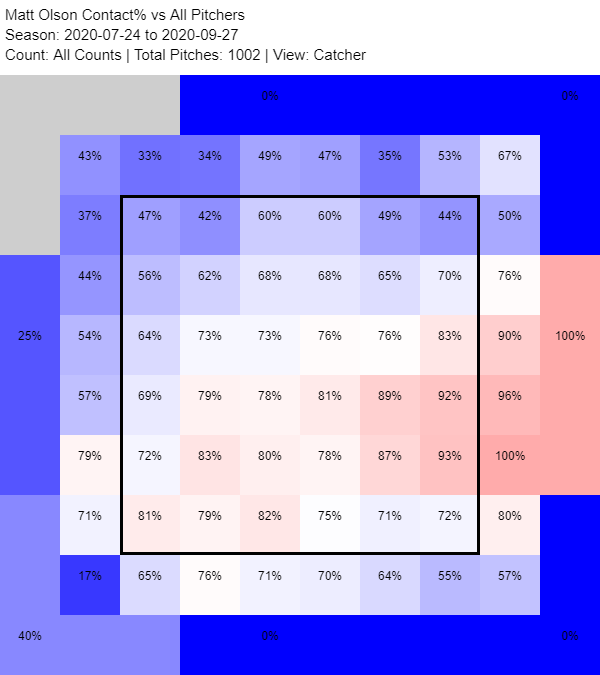
And now, compare that to his contact rates from this year:
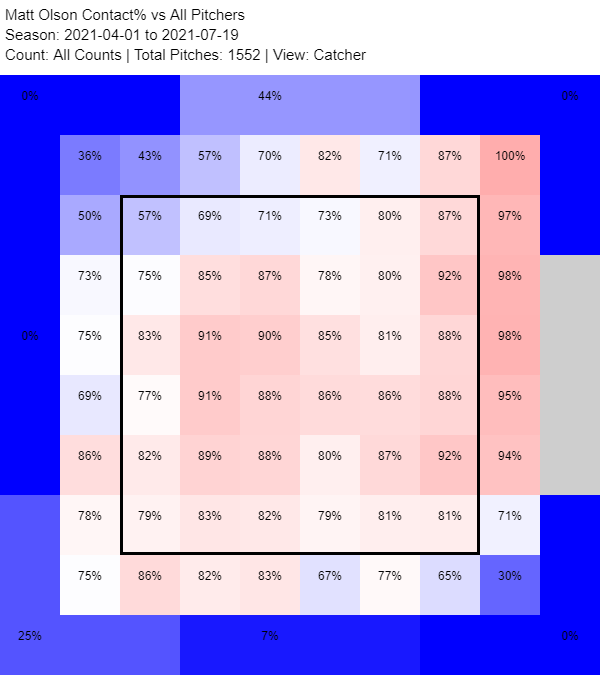
We do see more contact pretty much everywhere as expected, especially in the middle of the plate, but also the improvements at the top of the zone stand out. While the top of the zone generally still looks like his weakest area overall, the improvement here is quite substantial. In 2020, the two top-most rows inside the strike zone saw contact rates ranging from 42% to 70%. This year, things have improved considerably; in those same two rows, Olson’s contact rates range from 61% on the low end to 92% on the high end.
Even more to that point, Olson is doing much better this season at making contact on fastballs. For as good of a hitter as Olson is, it is oddly strange that he struggled so much at making contact on fastballs as much as he did, as last season he had a whopping 40.5% whiff rate on the pitch type, which was markedly up from his career norms of somewhere around the mid-20% range. It may have something to do with location, as it did look like Olson saw more high fastballs last season than he did in 2019:
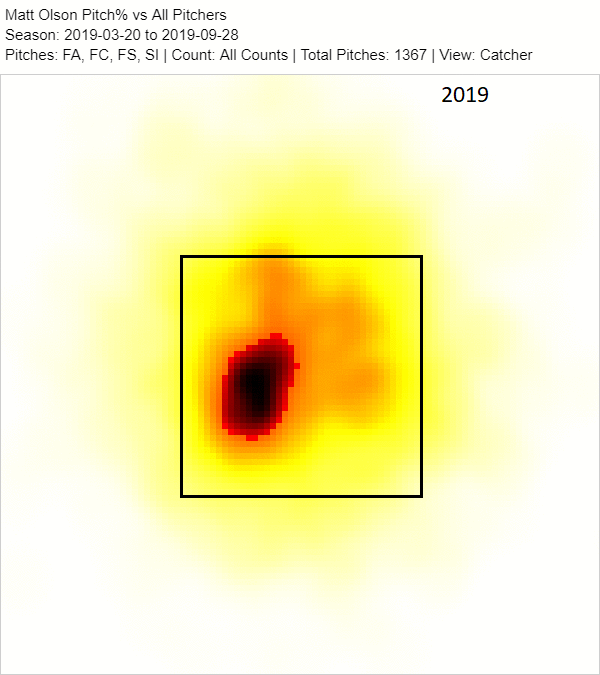
Considering we know of Olson’s overall top-of-the-zone struggles from last year, it makes sense then that we see that Olson struggled big-time at making contact on fastballs in the upper part of zone compared to elsewhere:
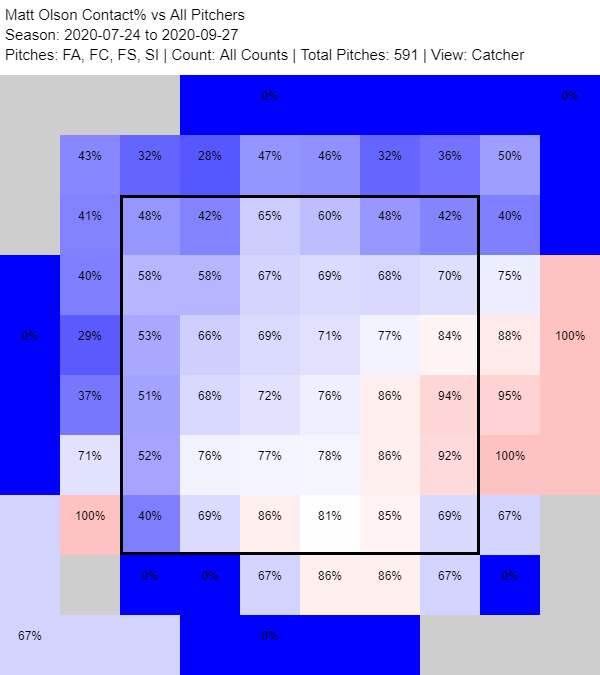
Once again, though, the difference between last season and this season is night and day:
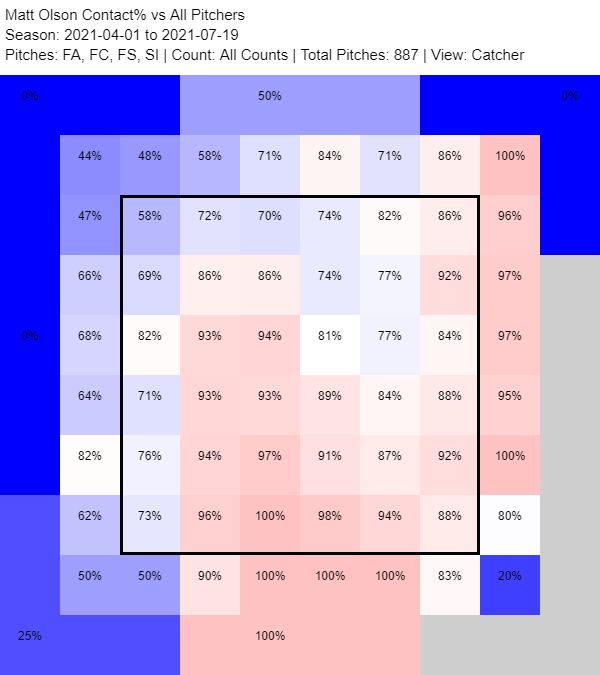
It certainly seems like Olson made a critical adjustment to help him hit pitches up in the zone. The team and Olson have spoken about a mysterious “little red machine” that was introduced to them from trade deadline acquisition Tommy La Stella last year. The machine apparently hurls balls with some rising action, which makes it harder for hitters to make contact if they’re working under the ball with their swings. Seeing as how fastballs with ride usually end up in the top of the zone, which was Olson’s biggest weakness, it does seem like this mysterious machine has been magical for Olson, as it certainly looks to have helped him overcome this in a major way.
Whatever the case may be, and depending on how much stock you want to put into this machine, there’s no doubting that Olson has been a much different hitter this season. He’s striking out less and making more contact than ever, all the while still crushing the ball at an elite rate. His hard contact and home runs came with the downside of many whiffs and strikeouts in the past. He did have excellent plate discipline to cancel a lot of those strikeouts out and still end up as a well-above-average hitter, but last season, that on its own wasn’t enough. He had more issues making contact than previously, and his overall results suffered.
Through adjustments focused on making more contact this season, Olson has been a more complete hitter, as he is having the best offensive season of his life.
Photo by Keith Gillett/Icon Sportswire | Adapted by Doug Carlin (@Bdougals on Twitter)


Hey Matt, check out Matt’s splits. I think there’s something telling in there as well. Good stuff – thanks.
Have you seen much of what Olson really looks like at the plate? He will always be a very high variance dude with serious batted ball metrics.I think it is more likely that this ends up closer to normal than this being the new normal. I have seen him play zero this year, but I have seen the way he goes about his business in the past.
Want to know how not complex some things are? Simply start with the bat more flat and ou will hit high pitches better. More tilt makes you hit balls down lower. Those are potentially sticky and easy adjustments, they are just trading one problem for another though. You can also use a whiffle ball pitching machine if you want to minimize gravity. We are in the generation of using technology to discover well known things.